“Give me a road-trip report,” says Editor Tuttle, tossing me the keys to the Harley Street Bob. “Let me know if the modifications we asked for made it into a decent cruiser-touring bike.”
Bob is your basic big twin, styled like a 1950s bobber, when it was the fashion to cut down, or bob, the fenders. Taking Harley’s H-D1 program to heart, we’ve decked it out with saddlebags, a windscreen and mid-mount instead of forward footpegs. A flat Drag handlebar instead of a Pullback or Mini-Ape leans the rider into the wind, and a Two-Up seat replaces the solo saddle. Hopefully it all makes Bob more distance worthy. I settle into the seat, turn the ignition on, push the button, the 103ci engine thunders into life, and I’m away.
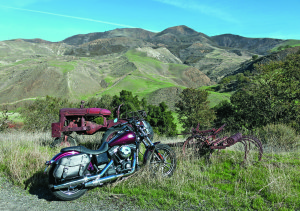
I’ve already got a route planned out, with many twisty roads, good photo opportunities and a lot of interesting history. California’s roads have certainly improved over the past 200 years. Back in the days of the Spanish, the Royal Road (El Camino Real) was merely a dirt track running from San Diego to San Francisco Bay. No motels back then, but 21 missions were scattered along the 500 or more miles, and they would offer the traveler shelter, protection and sometimes even food.
That dirt track eventually turned into U.S. Highway 101, with just about every off-ramp catering to the needs of the present-day traveler. For the motorcyclist, the stretch between the missions that runs from Santa Barbara to San Juan Bautista is the most interesting, as it avoids the large urban areas. And these 300-plus miles don’t have to be done on boring old U.S. 101, as smaller, much more entertaining roads also connect the missions. This FXDB is going to have a good workout on this trip. Bob is basically intended to cruise Main Street on Saturday night, and we are going to see how he works as a touring machine.
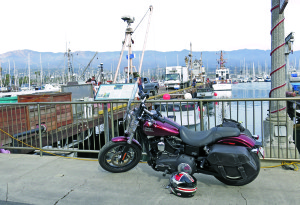
The city of Santa Barbara on the coast has a good harbor, and a hill overlooking the bay was a natural for a mission site, which was established in 1786. The current church was built in 1820, mostly destroyed by an earthquake in 1925, and then completely restored. Wander around the grounds, and then go in the church, and you will be impressed at the size and the beauty. Which was what the missionaries wanted to do: impress the natives. After all, it had worked well in Europe when the church—before the Catholic/Protestant split—built stupendous cathedrals and told the commoners, who lived in mud and wattle huts, that this was an example of the power of God.
The electric leg cranks up the Harley and we head north along Mission Canyon, turn west on State Route 192 then northwest on State Route 154 over San Marcos Pass at 2,224 feet, as high as I’m going to get on this trip. On the way up to the pass, I appreciate the limits of the cornering clearance on the right side—with enthusiastic cornering the lower muffler will scrape, and soon break off the large hose clamps that hold the chrome muffler-cover on. Solution is not to be so enthusiastic, and since the suspension and low 26.7-inch seat are intended for urban riding, I don’t fault the bike.
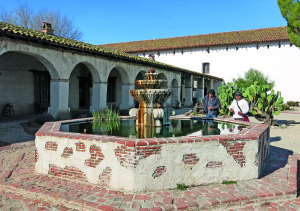
It is difficult to be unenthusiastic with that 103 engine…that baby really does kick the power out. Keeping the revs between four and five grand, Bob can stay with just about anybody…though the 5,500-rpm rev limiter is a reminder not to overdo it. Gas consumption runs about 38 mpg. The 6-speed tranny is typically Harley clunky, but works well. Sixth gear is definitely an overdrive, useful on the freeways.
Bob has short shock absorbers that provide very limited travel; best to avoid the bumps. The 49mm fork legs are kicked out to 29 degrees, three degrees more than on an Electra Glide, which does make parking-lot handling a trifle ponderous, but fine on the open road. Single discs are fore and aft, and Bob has anti-lock brakes. The stock wheels are spoked, with tube-type tires, a 19-inch front, 17-inch rear, but we’ve ordered up the black five-spoke mags—which come with tubeless Michelin Scorcher tires built specifically for Harley-Davidson. Tubeless tires are a blessing to a traveling man or woman, as most punctures can be quickly fixed.
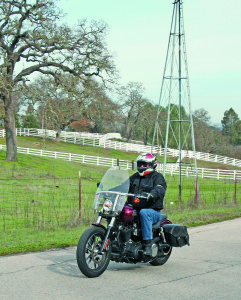
limited travel.
State Route 246 angles west off 154, going through the Santa Ynez Valley, and after less than five miles we are entering the town of Solvang, where the freshly painted Mission Santa Inés is quite apparent from the highway. This was one of the later missions, founded in 1804 after the missionaries realized that the fertile valley had a large native population, all potential converts. It could also support herds of cattle and flocks of sheep, all of which would add to the finances of the mission—which was getting less and less support from the Spanish government and the church establishment. These missions were essentially self-supporting little islands of Spanish life, home to several padres and a few soldiers, some with wives.
Moving along, we go west some 18 miles on 246, following the signs for La Purisima Mission State Historic Park. The other missions are all still part of the Catholic Church, but this one, founded in 1787, is now a historical park owned by the state. The place fell into disrepair in the latter part of the 19th century and the church sold off the property. In 1934, in the midst of the Great Depression, the state bought much of the land and established a Civilian Conservation Corps camp there, paying otherwise unemployed men to restore the mission. The park now covers almost a thousand acres, with an excellent museum. And Catholic services are held once a year at the church, on the day the mission was founded, December 8th.
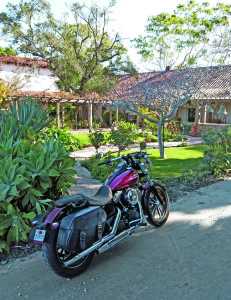
Leaving La Purisima, we head over the Purisima Hills on the well known—to local motorcyclists—Harris Grade Road. Delightful! That connects with State Route 1, which wends its way northward until it merges with U.S. 101 at Pismo Beach. Just below the speedometer is a computer readout, which can tell me everything from the time of day to how far I’ve gone since the last fill-up. On the 101, I shift into top gear and my gear indicator/tach is reading 6/2,750, which equates to 75 mph; the speed-limit signs read 65. The mirrors on the rubber-mounted drag bars vibrate a bit too much to be useful, but I do see flashing red and blue lights coming up behind me. And past me, whew; the sheriff has more important things to do.
After 12 highway miles, we exit into the city of San Luis Obispo and its mission, established in 1772. It was one of the larger and more important missions 200 years ago, and today is a focal point for activity in that city. Bob’s windscreen is the quickly removable type, so you can leave it in your motel room and become a downtown cruiser; put it on and you have good protection when traveling. The leather bags are attractive, but a bit small, as they have to allow for the twin shock absorbers. Our Bob’s mid-mount footpegs are located back nearer the seat, an H-D1 option that I like, rather than the way-forward cruiser style that is standard.
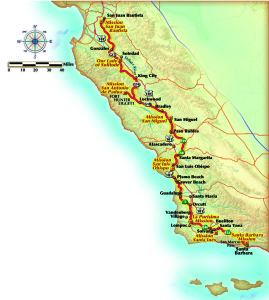
Bright and early, we take off for San Miguel, about 35 miles north on U.S. 101, a few more for anyone taking the far more enjoyable route via State Route 58, State Route 229, Creston Road and River Road, running up the east side of the Salinas River. From River Road we can see the little town of San Miguel in the distance, then cross the river and we’re at the mission.
In 1806 a fire destroyed most of the original mission, and in 2003 an earthquake almost caused the replacement church to collapse, but not quite. And it has now all been earthquake-proofed…we hope.
Heading off to the northwest we get to Fort Hunter Liggett, and in the middle of this military reservation we find the mission of San Antonio de Padua, established in 1771. This has good land, with the Nacimiento River running close by, and prospered for the next 50-some years until Mexico declared its independence from Spain in 1823. Since the Catholic Church had sided with the Spanish, the Mexican republic was not in the mood to give any assistance to these missions. San Antonio’s buildings were pretty much in a state of collapse until 1948, when the Hearst family, who had bought the land, provided money for a total restoration and returned the mission to the church. For me, this is the most attractive mission in California, with a huge olive tree out front and a lovely garden inside.
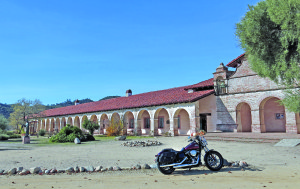
Two roads used to connect San Antonio with missions to the north, one headed north and west to Carmel, the other east to the Salinas Valley and Mission Soledad. Both roads are closed now, so we head back the way we came into the fort on County Road G14 and go north toward King City. Staying on the west side of the Salinas River, we arrive at Our Lady of Solitude, a hard-luck mission if there ever was one. Established in 1791, the padres did not know that the upper Salinas Valley suffers very cold and wet winters. And occasionally floods. By the time the Americans took over California, the adobe buildings had literally melted away. Today a new mission chapel, built in 1955, stands next to the old ruins.
Back roads lead us to the farming town of Gonzales, where we cross over both the Salinas River and U.S. 101 to pick up Old Stage Road, which skirts along the eastern edge of the valley to meet with the San Juan Grade Road. This goes over the Gabilan Range of hills to the San Juan Valley and San Juan Bautista. The mission here was founded in 1797, and it was in such an attractive place that it soon attracted more Europeans than natives…which was not quite the intent of the missionaries.
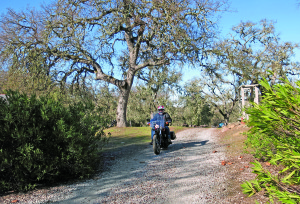
Today, the mission itself remains with the Catholic Church but is surrounded by a state park. A large grassy square, an acre or more, is in front of the mission, with several 19th century buildings including a hotel and a stable on the far side. A park ranger told me that this is a favorite destination for school outings, and hundreds of children can be seen gleefully cavorting most any fine day.
There you have it: good road trip on a good bike, fairly well set up for touring…although I would appreciate longer shock absorbers next time.
To learn more about Harley-Davidson’s H-D1 Program, CLICK HERE.
(This article Cruiser or Touring Bike? Taking Harley’s 2013 FXDB Street Bob on a Mission was published in the May 2013 issue of Rider magazine.)

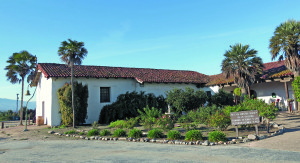
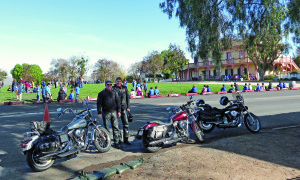







Cant see the pics, would make the story better!
Sorry you can’t see the photos Chris. We’ve checked on multiple computers and different browers and they’re showing up just fine for us. What device and browser are you using?
Was on a tablet, working fine now.
Thanks
This article is about as useful as tits on a boar hog. It is far less a review and far more a rambling recap of the author’s free CA road trip on a Harley. Only 21 of the 2,033 words were strung together consecutively to offer any sort of a meaningful review – “good road trip on a good bike, fairly well set up for touring…although I would appreciate longer shock absorbers next time” – and even that was pretty weak. There goes five minutes I’ll never get back.
Does anyone have pictures of SB Harley Davison from the 70’s when it was on state st. ?